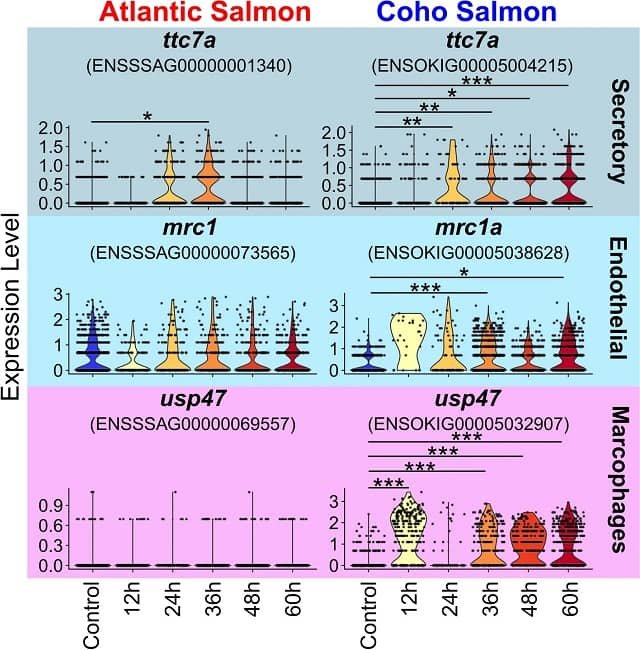
Sea Lice, tiny parasitic crustaceans, have long plagued Atlantic salmon aquaculture, causing significant economic losses, environmental damage, and animal welfare concerns. In contrast, its Pacific cousin, the coho salmon, appears to have developed remarkable resistance to these pests.
Scientists have been puzzled by this disparity, trying to understand the underlying mechanisms that protect coho salmon from these persistent parasites.
In this regard, a team of scientists from The Roslin Institute at the University of Edinburgh (UK), the Institute of Aquaculture at the University of Stirling (UK), the University of Santiago de Compostela (Spain), the University of Prince Edward Island (Canada), Nofima AS (Norway), Benchmark Genetics (UK), and Deakin University (Australia) characterized the cellular and molecular responses of Atlantic salmon (Salmo salar) and coho salmon (Oncorhynchus kisutch) to sea lice (Lepeophtheirus salmonis) using single-nucleus RNA sequencing.
Detrimental Impacts
Sea lice are parasites that feed on the skin and fins of fish, causing open wounds that can lead to infections, reduce the market value of farmed fish, and have knock-on effects on wild salmon populations.
Several treatments have been developed to address sea lice infestations in Atlantic salmon aquaculture, which cost the industry more than £700 million annually, but they are often expensive and ineffective. They can also be harmful to the environment and negatively affect animal welfare.
The Coho Salmon Advantage: A Model of Resistance
Unlike the vulnerability of Atlantic salmon, coho salmon exhibits remarkable natural resistance to sea lice. When attacked, coho salmon develops a rapid and effective immune response, encapsulating and expelling the parasites.
To unravel the complexities of this biological puzzle, researchers have employed a cutting-edge technique called single-nucleus RNA sequencing. This powerful tool allows scientists to analyze the genetic activity of individual cells within the skin of Atlantic and coho salmon when faced with sea lice.
By examining the different layers of the skin, including the epidermis and dermis, the researchers identified distinct cell types and their specific roles in the immune response. While both salmon species exhibit a general immune and wound-healing response, coho salmon demonstrates a significantly amplified response focused on keratinocytes, the primary cells of the skin.
Stay Always Informed
Join our communities to instantly receive the most important news, reports, and analysis from the aquaculture industry.
A Breakthrough in Understanding Sea Lice Resistance
After exposing both species to the parasites, the researchers investigated the cell types and gene expression patterns of their responses by analyzing skin samples using a new type of RNA sequencing that allows for the characterization of gene expression in individual cells.
By analyzing the genetic activity of individual cells in both species when exposed to sea lice, the researchers discovered a complex interplay of factors contributing to the impressive resistance of coho salmon.
The study found that both salmon species develop an immune and wound-healing response to sea lice infestation. However, coho salmon exhibits a significantly stronger and faster reaction, effectively encapsulating and expelling the parasites. This enhanced response is centered on keratinocytes, specialized skin cells that form multiple layers.
The Role of Keratinocytes in Sea Lice Resistance
The research has revealed a fascinating hierarchy within the keratinocyte layers of coho salmon skin. Basal keratinocytes, the deepest layer, appear to orchestrate the behavior of intermediate and superficial keratinocytes. When faced with sea lice, these keratinocytes work together to create a formidable barrier, ultimately leading to the parasite’s shedding.
“We were able to identify with unprecedented resolution the cell types responsible for the swelling skin response that coho salmon uses to resist sea lice, as well as the cells that sea lice target in Atlantic salmon to weaken this host species. These insights pave the way for the development of transformative therapies to counter this devastating parasite,” said Dr. Sarah Salisbury, Postdoctoral Researcher at the Roslin Institute.
Implications for the Salmon Industry
By understanding the molecular mechanisms behind coho salmon’s resistance to sea lice, scientists have identified potential targets for developing innovative strategies to protect Atlantic salmon. These findings open the door to biotechnological interventions that could bolster the immune response of Atlantic salmon, making it more resistant to sea lice infestations.
Through gene editing, it may be possible to enhance the resistance of Atlantic salmon to sea lice by targeting the genes underlying its susceptibility, and coho salmon’s resistance to the parasites, the research team suggests.
The path to a sustainable and ethical salmon aquaculture industry is complex, but this research represents a significant advance. By harnessing the power of nature’s own defenses, we can work towards a future where salmon farming coexists harmoniously with the marine environment.
The study was funded by the Norwegian seafood industry research fund, FHF, and the Biotechnology and Biological Sciences Research Council (BBSRC).
Contact
S. J. Salisbury
The Roslin Institute and Royal (Dick) School of Veterinary Studies, University of Edinburgh
Edinburgh, UK
Email: sarah.salisbury@roslin.ed.ac.uk
Reference (open access)
Salisbury, S.J., Daniels, R.R., Monaghan, S.J. et al. Keratinocytes drive the epithelial hyperplasia key to sea lice resistance in coho salmon. BMC Biol 22, 160 (2024). https://doi.org/10.1186/s12915-024-01952-8
Editor at the digital magazine AquaHoy. He holds a degree in Aquaculture Biology from the National University of Santa (UNS) and a Master’s degree in Science and Innovation Management from the Polytechnic University of Valencia, with postgraduate diplomas in Business Innovation and Innovation Management. He possesses extensive experience in the aquaculture and fisheries sector, having led the Fisheries Innovation Unit of the National Program for Innovation in Fisheries and Aquaculture (PNIPA). He has served as a senior consultant in technology watch, an innovation project formulator and advisor, and a lecturer at UNS. He is a member of the Peruvian College of Biologists and was recognized by the World Aquaculture Society (WAS) in 2016 for his contribution to aquaculture.



